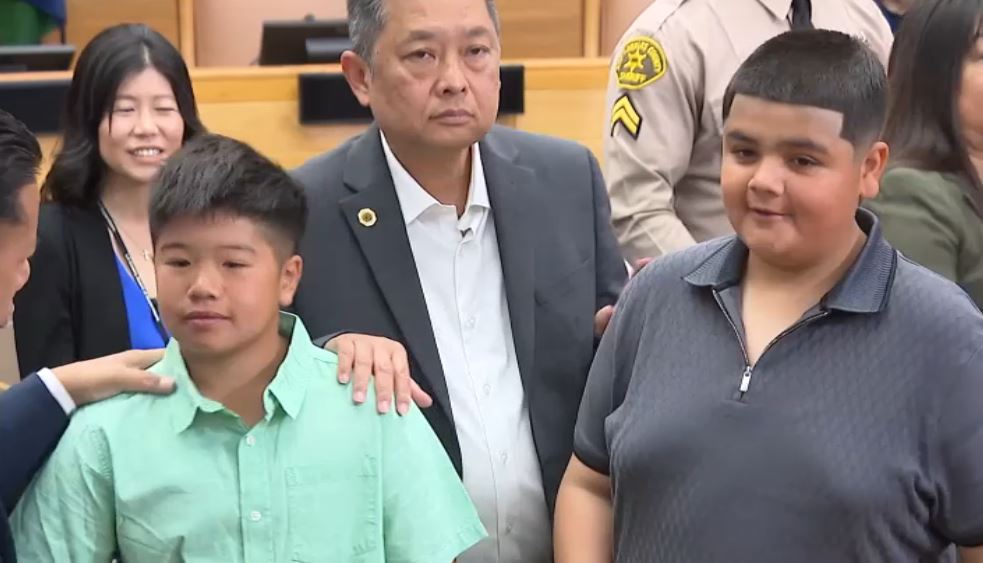Residents living in the path of a deadly fire picked up the pieces. Beverly White reports for the NBC4 News at 11 p.m. on Friday, June 24, 2016.
Governor Jerry Brown on Friday issued a state of emergency for Kern County due to the effects of the Erskine Fire, which has claimed two lives, caused the evacuation of thousands of residents, burned thousands of acres and damaged homes and critical infrastructure.
Two people, an elderly couple, died in the fire that exploded in size Friday to nearly 47 square miles, consuming about 100 structures, including homes, as it tore through several rural communities in central California, northeast of Bakersfield, authorities said. It was five percent contained.
In an afternoon news release, Brown issued a statement expressing sympathies for the victims' families.
"Anne and I extend our heartfelt sympathies to everyone impacted by this destructive blaze," he said. "We join all Californians in expressing our gratitude to the courageous firefighters, emergency personnel and volunteers working tirelessly throughout Kern County to help residents and extinguish this fire."
The wildfire erupted near Lake Isabella late Thursday afternoon amid heat in the 90s and single-digit humidity, climbing over at least three ridges into hillside neighborhoods, Kern County fire Capt. Tyler Townsend said. The latest measurement at midmorning Friday was more than double the previous estimate.

"The forces of nature collided with a spark," Kern County Fire Chief Brian Marshall said. "The mountainous terrain, five years of drought and wind gusts of over 20 mph all drove a fire over 11 miles in 13 hours."
There was no containment estimate Friday afternoon.
The Kern County Fire Department confirmed Friday that two people died. Authorities placed yellow police tape in front of a home where one of the fatalities occurred on McCray Road, which connects the communities of Squirrel Mountain Valley and Mountain Mesa to the south of Isabella Lake near Highway 178.

Details about the deaths and when they occurred were not immediately available.
About 1,500 structures remain threatened and thousands of residents, some from neighborhoods left in ashes, are under evacuation orders. More than 350 firefighters were battling the blaze, and hundreds more were en route to assist. Two firefighters suffered smoke-related injuries, officials said.

Video from fire officials at the scene showed hillside homes along dirt roads consumed by heavy flames in Squirrel Mountain Valley, a community of about 500 people. Some houses were reduced to little more than embers on the ground, while others were deep in flames.
Shelly Hayes helped her mother-in-law get out of her home in Mountain Mesa, one of the neighborhoods in which several homes were destroyed.
"The smoke was horrendous," said Hayes "It was terrible.
"There were three houses that went up right in front of us."

Smoky haze could be seen for miles, and orange flames lit the evening air as planes and helicopters attacked the blaze.
"I've never been in a wildland fire where I've seen so many homes burn," said Townsend, who has been in the area for nearly a decade. "It's one of the most devastating I've ever seen."
David Klaippel, 78, a retired police officer, said he didn't see much of a threat after receiving an automated call advising him to leave. That changed dramatically within an hour Thursday afternoon.
Local
Get Los Angeles's latest local news on crime, entertainment, weather, schools, cost of living and more. Here's your go-to source for today's LA news.
"I've never been so close to a fast-moving, ferocious fire. It was unbelievable," said Klaippel, who later learned his house had caught fire. "I almost didn't have time to get out."
Many houses in the area have propane tanks, adding to the danger, he said. Power and cellphone outages were also reported.
The small rural communities of South Fork, Weldon, Onyx, Lakeland Estates, Yankee Canyon and Mountain Mesa were also under evacuation orders, but some residents refused to leave, Townsend said.
Kernville Elementary School was being used as the primary shelter for evacuees. About 40 evacuees were moved from the Lake Isabella Senior Center to the elementary school, officials said.
Elsewhere in the state, cooler weather helped crews fighting two fires that burned more than 8 square miles of chaparral and brush in the Angeles National Forest and foothill communities northeast of Los Angeles. The fires were 15 percent contained.
More than 1,300 homes were evacuated during the 4-day-old blaze, but around half have been allowed back. One of the fires broke out Monday when a car ran off a highway. No homes have burned.
Firefighters also are making progress on the Sherpa fire in Santa Barbara County, which was 93-percent contained Friday. The fire began Wednesday and burned through nearly 8,000 acres near Goleta.
Near the San Diego County border with Mexico, an 11-square-mile fire was 35 percent contained after burning five homes. A majority of evacuees were cleared to return at 6 p.m. Thursday.
A heat wave coupled with nightly wind gusts drove the fires earlier in the week before slightly cooler weather took hold. But National Weather Service forecasts warned red-flag conditions of extreme fire danger could return by evening.
The continuing drought and lack of significant rain from the winter El Niño has made Southern California ripe for what could be one of the worst wildfire seasons on record. An El Niño weather pattern brought near-normal snowfall to parts of California last winter, but most of the precipitation stayed to the north of Southern California, leaving the region with dry brush to fuel fire growth.
The Associated Press contributed to this report.



